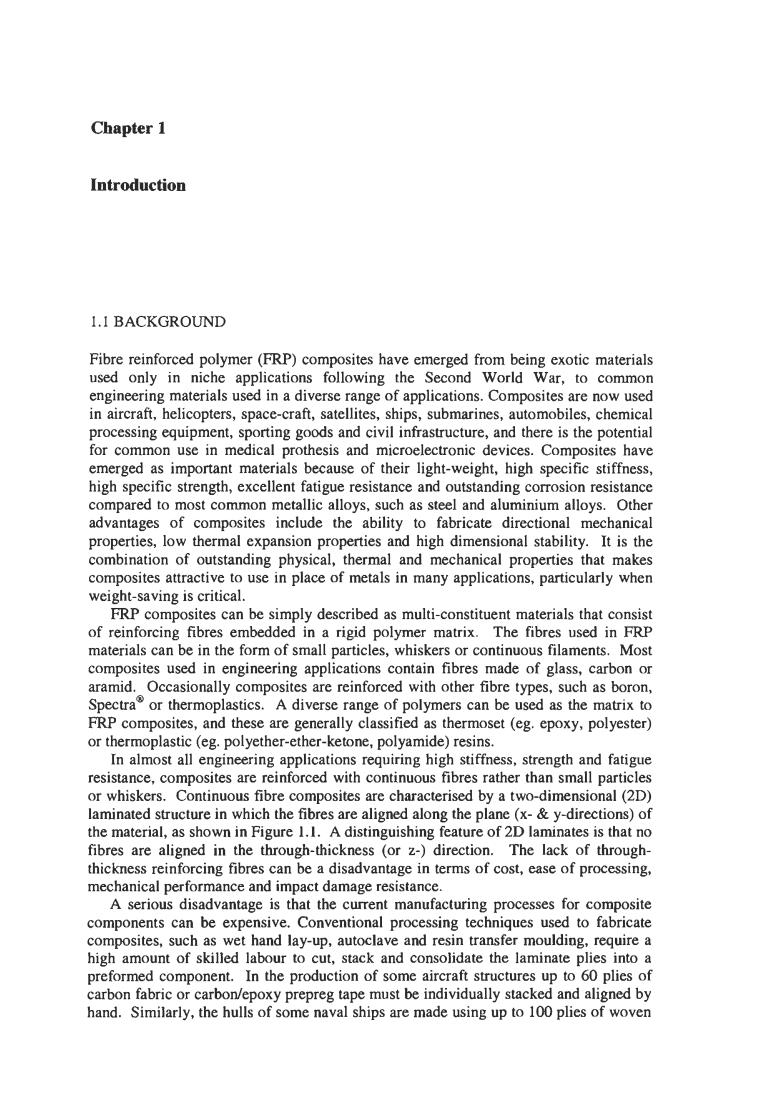正在加载图片...

Chapter 1 Introduction 1.1 BACKGROUND Fibre reinforced polymer(FRP)composites have emerged from being exotic materials used only in niche applications following the Second World War,to common engineering materials used in a diverse range of applications.Composites are now used in aircraft,helicopters,space-craft,satellites,ships,submarines,automobiles,chemical processing equipment,sporting goods and civil infrastructure,and there is the potential for common use in medical prothesis and microelectronic devices.Composites have emerged as important materials because of their light-weight,high specific stiffness, high specific strength,excellent fatigue resistance and outstanding corrosion resistance compared to most common metallic alloys,such as steel and aluminium alloys.Other advantages of composites include the ability to fabricate directional mechanical properties,low thermal expansion properties and high dimensional stability.It is the combination of outstanding physical,thermal and mechanical properties that makes composites attractive to use in place of metals in many applications,particularly when weight-saving is critical. FRP composites can be simply described as multi-constituent materials that consist of reinforcing fibres embedded in a rigid polymer matrix.The fibres used in FRP materials can be in the form of small particles,whiskers or continuous filaments.Most composites used in engineering applications contain fibres made of glass,carbon or aramid.Occasionally composites are reinforced with other fibre types,such as boron, Spectra or thermoplastics.A diverse range of polymers can be used as the matrix to FRP composites,and these are generally classified as thermoset (eg.epoxy,polyester) or thermoplastic (eg.polyether-ether-ketone,polyamide)resins. In almost all engineering applications requiring high stiffness,strength and fatigue resistance,composites are reinforced with continuous fibres rather than small particles or whiskers.Continuous fibre composites are characterised by a two-dimensional(2D) laminated structure in which the fibres are aligned along the plane (x-&y-directions)of the material,as shown in Figure 1.1.A distinguishing feature of 2D laminates is that no fibres are aligned in the through-thickness (or z-)direction.The lack of through- thickness reinforcing fibres can be a disadvantage in terms of cost,ease of processing, mechanical performance and impact damage resistance. A serious disadvantage is that the current manufacturing processes for composite components can be expensive.Conventional processing techniques used to fabricate composites,such as wet hand lay-up,autoclave and resin transfer moulding,require a high amount of skilled labour to cut,stack and consolidate the laminate plies into a preformed component.In the production of some aircraft structures up to 60 plies of carbon fabric or carbon/epoxy prepreg tape must be individually stacked and aligned by hand.Similarly,the hulls of some naval ships are made using up to 100 plies of wovenChapter 1 Introduction 1.1 BACKGROUND Fibre reinforced polymer (FRP) composites have emerged from being exotic materials used only in niche applications following the Second World War, to common engineering materials used in a diverse range of applications. Composites are now used in aircraft, helicopters, space-craft, satellites, ships, submarines, automobiles, chemical processing equipment, sporting goods and civil infrastructure, and there is the potential for common use in medical prothesis and microelectronic devices. Composites have emerged as important materials because of their light-weight, high specific stiffness, high specific strength, excellent fatigue resistance and outstanding corrosion resistance compared to most common metallic alloys, such as steel and aluminium alloys. Other advantages of composites include the ability to fabricate directional mechanical properties, low thermal expansion properties and high dimensional stability. It is the combination of outstanding physical, thermal and mechanical properties that makes composites attractive to use in place of metals in many applications, particularly when weight-saving is critical. FRP composites can be simply described as multi-constituent materials that consist of reinforcing fibres embedded in a rigid polymer matrix. The fibres used in FRP materials can be in the form of small particles, whiskers or continuous filaments. Most composites used in engineering applications contain fibres made of glass, carbon or aramid. Occasionally composites are reinforced with other fibre types, such as boron, Spectra@ or thermoplastics. A diverse range of polymers can be used as the matrix to FRP composites, and these are generally classified as thermoset (eg. epoxy, polyester) or thermoplastic (eg. polyether-ether-ketone, polyamide) resins. In almost all engineering applications requiring high stiffness, strength and fatigue resistance, composites are reinforced with continuous fibres rather than small particles or whiskers. Continuous fibre composites are characterised by a two-dimensional (2D) laminated structure in which the fibres are aligned along the plane (x- & y-directions) of the material, as shown in Figure 1.1. A distinguishing feature of 2D laminates is that no fibres are aligned in the through-thickness (or z-) direction. The lack of throughthickness reinforcing fibres can be a disadvantage in terms of cost, ease of processing, mechanical performance and impact damage resistance. A serious disadvantage is that the current manufacturing processes for composite components can be expensive. Conventional processing techniques used to fabricate composites, such as wet hand lay-up, autoclave and resin transfer moulding, require a high amount of skilled labour to cut, stack and consolidate the laminate plies into a preformed component. In the production of some aircraft structures up to 60 plies of carbon fabric or carbodepoxy prepreg tape must be individually stacked and aligned by hand. Similarly, the hulls of some naval ships are made using up to 100 plies of woven